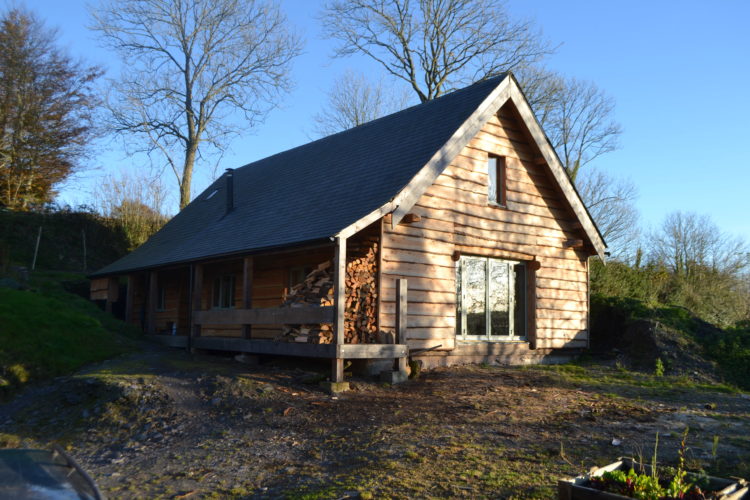
It’s been a year since we went ‘off-grid’ for electricity – so I thought it might be useful to take a long view of our experience.
Mains (utility) electricity goes right past our house, but when we discovered that it would cost £10k for us to connect to it, we decided to spend the money on a 4kw solar array, 48V/440Ah batteries, Multiplus 5000VA, and MPPT 150/100.
Quite a lot of hand-wringing went into that decision: My wife and I had lived on board a sailing boat for seven years and, to be honest, had grown tired of managing our resources – water; electricity; fresh produce; and money. We dreamed that when we lived in a house again, it would be connected to the electricity grid and we’d be able live like ‘normal’ people …turning on a light without having to check the battery voltage.
 Our on-board electricity capacity is 12V/210Ah …and it’s a sailing boat, so we don’t generate electricity when we’re travelling. We do have an engine – a 1956 Perkins P4 – but prefer manoeuvring under sail because it’s more fun. Consequently electricity is always scarce. So, contemplating going off-grid in the (straw-bale) house we were building gave us a feeling of ‘…here we go again’.
Our on-board electricity capacity is 12V/210Ah …and it’s a sailing boat, so we don’t generate electricity when we’re travelling. We do have an engine – a 1956 Perkins P4 – but prefer manoeuvring under sail because it’s more fun. Consequently electricity is always scarce. So, contemplating going off-grid in the (straw-bale) house we were building gave us a feeling of ‘…here we go again’.
We needn’t have worried – excepting a period of about one month, back in the summer, when something was clearly ‘wrong’ (of which more later) we have been fairly amazed at how well our installation converts sunlight into glorious power. Lashings of it.
To put things into perspective:
- We have a 5kVA generator for back-up …during the last 12 months is has been run for just 20 hours.
- We aim to use no more than 20% of our battery capacity (SOC = >79%).
- We always use domestic appliances according to circumstance: Washing machine on sunny days. Fridge/Freezer off in winter.
- Because our battery SOC is always relatively high, power produced by our solar panels is often attenuated by the MPPT.
- Typical daily power consumption is 8KWh in the summer; and 3KWh in the winter. (In the winter we turn the fridge-freezer off; and domestic hot water is heated by a wood-burning appliance.)
I mentioned a moment ago that something went wrong in the summer: Back in July (we’re in the northern hemisphere) we noticed that our 4kW PV array was producing a maximum 1200W. Consequently the battery charge rate was permanently in ‘bulk’, and we were never achieving a full-charge. (It’s worth mentioning here that they’re not Victron supplied panels …and in any case the problem wasn’t with the panels).
One problem was easy to diagnose – there’s an Ash tree growing to the South-East of our rooftop array, just ten metres away. Ash trees tend to come into leaf quite late in the spring. Their leaves are ‘spare’ at first, but fill-out as the summer progresses. When the tree is bare the panels get full-sun by 13:00. …but in late summer, that doesn’t happen until 14:30 – after peak power generation opportunity has already passed. So this winter we’re going to take the tree down.
Checking the voltage of each of the 15 individual panels from inside the house I noticed that although twelve of them were reading 29V – 32V (the polycrystalline panels have 60 cells); three of them were reading 14V – 19V …and the reading was constantly fluctuating. On the roof the suspect panels read a full 30V – regardless of which side of the MC4 connectors I shoved my voltmeter probes. That suggested there was a fault in the new and unbroken wiring – which seemed unlikely. I was so baffled I did nothing for about a fortnight. Then an electrical engineer friend of mine said; Oh well, go up and change the connectors anyway, and then you’ve eliminated them from the enquiry.
Fitting new connectors brought the ‘suspect’ panels straight back to circa 30V…and solved the problem.
I noticed that the connectors I removed were damp and corroded – then it occurred to me that when I had tested them, and the voltmeter readings seemed OK. it was because the force I used to invaded the cable sheath with the sharp probe of the Voltmeter, actually improved the MC4 terminal contact – so they they read a full 30V.
Some people recommend ‘Denzo’ tape to prevent corrosion – that stuff that looks like bandage soaked in toffee. But having had the connector problem, I’m tempted to go back on the roof and hardwire all MC4 connectors. After all, the panels are supposed to have a 25 year life.
We’re off grid for everything: electricity, water, sewerage – and we burn wood for heating, cooking and hot water. The freedom of that goes way beyond just being ‘bill-free’. I could write a whole blog on the misery of billing errors; supplier-switching; comparison sites – but no one would read it …including me! So if you, who read these words, are thinking of going off-grid for electricity – but hesitating – here’s my advice: Go for it!
Our Victron system comprises:
MultiPlus 48|5000|70 inverter/charger
Soar charger is a MPPT150|100
If you’ve ever wanted to look inside a Straw Bale house – here is a video made by Home Building and Renovating Magazine who awarded it Spirit of Self-Build category winner.
Previous instalments of this Straw Bale blog – oldest first:
Justin and Linda Tyers -Off Grid Journey
By : Justin Tyers














